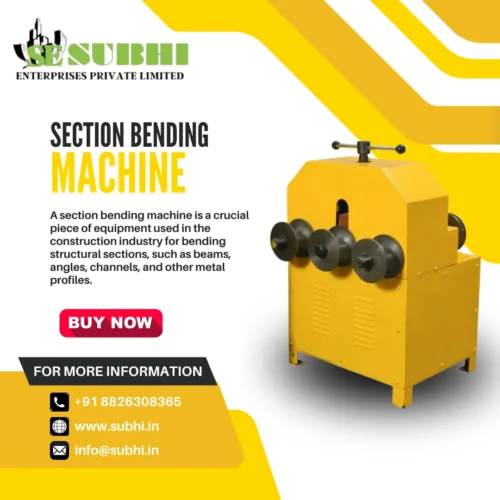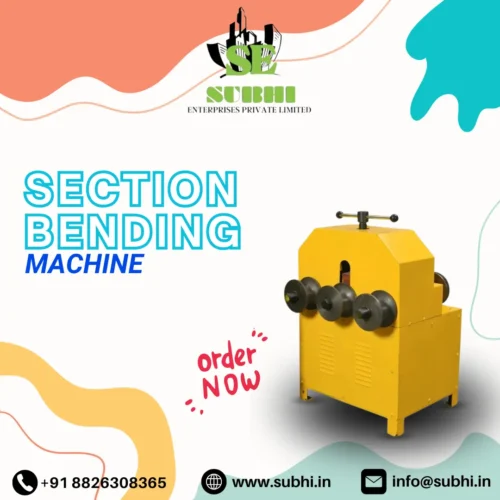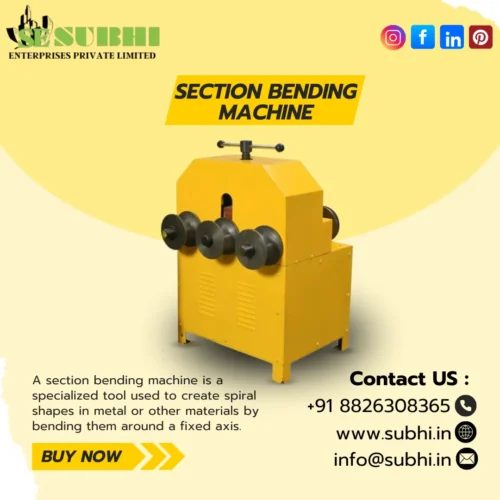Manufacturing and construction industries of today heavily rely on operations that can shape metal sections into precise forms. This is possible by section bending machines. For bending beams, angles, channels, or flat bars, a section bending machine is an invaluable tool used for shaping intricate curves and bends within metal structures.
In the article, we will explain the definition of section bending machines and their workings, classification, application, and merits. Also, we will discuss the unique features to look for when selecting one, and present how these machines are applied in different industries.
What is a Section Bending Machine?
A section bending machine is also known as a section bender or roll bender, and refers to a specific machine that bends different profiles of metal sections like beams, angles, channels, and other structural shapes. With this machine, it is possible to obtain both simple and complex curves with high accuracy in radius and angle.
Such machines progressively impose pressure to a metal piece using a set of rollers, bending the material without distorting it or inflicting any form of significant damage. Unlike manual bending techniques, section bending machines offer greater flexibility with regards to the extent and control of the bending process which makes them best suited for the creation of complex shapes that require a high level of accuracy.

Operation of a Section Bending Machine?
The basic operation of a section bending machine uses three rollers which are set in a triangular position. The machine usually consists of:
1. Top Roll: The top roll serves the purpose of feeding the material into the machine and it guides the piece throughout the process. This roll applies a downward force to the metal section to assist in its positioning.
2. Bottom Rolls: Typically, there are two bottom rolls, one is movable and the other is static, the piece can be set to vary the radius of the bend. The fixed roll does not move, while the moveable one can be adjusted to change the amount of pressure applied to the material. The additional curvature is controlled through the moveable bottom roll.
3. Adjustable Parameters: Machines of this type usually have automated system which allows the operator to set the desired speed, position, and force to be applied to the workpiece in order to produce an accurate bend. After the metal piece is put in between the rolls, the press applies pressure and rotation to shape the material as required. The operator is able to set the degree of curvature needed by adjusting the rolls and the height of the bend.

Classification of Section Bending Machines
In general, a machine's purpose is defined by the sector it caters to. Similarly, section bending machines are categorized based on their shape and functionality. Broadly, these machines are classified into Horizontal Section Bending machines and Vertical Section Bending machines.
Horizontal Section Bending Machines : Horizontal Section Bending Machines are designed with the rolls positioned laterally. The material is placed into the machine, and the rollers start bending the sections around the horizontal axis. This machine is best for heavy duty and larger sections. These machines are used most frequently in industries that require construction and shipbuilding.
Vertical Section Bending Machines : For vertical section bending machines, the rolls are set standing up allowing the material to be fed in vertically. These machines are great for bending small sized sections and lighter materials. This machine best suited for accuracy and compact bends in narrow sizes.
Universal Section Bending Machines : These types of machines are broad in scope as they can work on different materials and sections. Things ensures step bending of more complex shapes and angles with very fine precision. Universal section bending machines are usually made with a cut with more than two rollers and can work on much deeper sections. (read)
Specifications On Finding A Section Bending Machine
As with any new technology investment, planning the purchase of a section bending machine should start with a feature set that defines how the machine will be used. These are some features to focus on:
1. Roller Material and Construction : As with other pieces of equipment, the rollers are one of the section bending machine’s most crucial components. If the roller needs to last long and require minimal maintenance, specialized alloys are selected as they mechanical properties resistant to wear.
2. Digital Controls : The modern section bending machines incorporate digital controls for more accurate management of the machine’s parameters such as bending radius, speed, and force. This machine is especially designed for accuracy and consistency in the performance of complex bends.
3. Hydraulic vs. Mechanical Machines : Section bending machines come in both hydraulic and mechanical styles. The hydraulic machines provide better control and flexibility for bending thicker materials but are bulkier. Mechanical machines usually have a lower cost and a simpler construction but are not as precise are more complex systems.
4. Bending Capacity : A machine’s bending capacity is critical when purchasing a machine. It usually corresponds to the maximum bending thickness, length, width of material that could be used in the machine. One needs to choose a machine with sufficient bending capacity for different types of sections and materials.
5. Safety Features : The issue of safety always comes first in a manufacturing environment. It is recommended to use machines that have inbuilt safety features like emergency stop buttons: with these features, safety guards and protective mechanisms bones are put in place to limit chances of injuries while at work.
6. Ease of Maintenance : To achieve maximum efficiency, section bending machines have specific maintenance procedures that must be performed on a regular basis. Serviceable machines with spare parts readily available and clear maintenance instructions tend to minimize downtime, making them ideal for businesses.(click)

Applications of Section Bending Machines
Section bending machines are used across multiple industries for processes that require bending metal sections.
1. Construction : Section bending machines are often employed in construction to bend steel and other metallic beams into structural elements such as curved arches and bridges, which are essential in the construction of modern buildings. These machines make it possible to bend columns and beams accurately to match the architectural design of a structure.
2. Ship building : The construction of ships entails bending large metal sections for the hull, deck beams, bulkheads, and frames. Section bending machines are critical in this regard because complex curved surfaces are crucial in shipbuilding, and these machines offer the needed precision.
3. Steel Fabrication : In steel fabrication, section bending machines help process beams, plates and other structural features into different parts of frames, supports, and even other specialized structures. These machines can fabricate components for a diverse range of different applications.
4. Automotive Manufacturing : In this industry, section bending machines are used to cut and bend metal plates into specific shapes and allow for the curved pieces of frame, body panels, as well as other parts of the vehicle to be manufactured. Their attention to detail enables the precise crafting of parts that fit perfectly and functionally.
5. Architectural Design : Section bending machines are freely used by architects and designers for creating highly exquisite building parts such as railings, arcs, façade, etc. The ability to bend metals to complex shapes allows even the most advanced very innovative forms to be created without the arduous processes that used to exist.
Benefits of Using Section Bending Machines
Bringing in section bending machines would be of great help to manufacturers and fabricators due to the following reasons
1. Precision and Accuracy : This Machine is able to provide precision unlike any other method of bending steel. Having the ability to automate the bending process ensures that every steel plate is bent exactly the same, leading to accurate results every time.
2. Increased Productivity : These machines are purposely built for that level of productivity. This machine is capable of repetitive bending without the need for manual processes so less time is spent per piece which results in an immediate boost in productivity. It becomes much more manageable for manufacturers to work within deadlines.
3. Adaptability : These machines can bend different materials and shapes which makes them useful for many things. This machine can work on mild steel, stainless steel, and even aluminum.
4. Value for Money : This machine may seem costly from the start. It seems to be more economical in the long run due to the relatively cheap labor. Moreover, its high precision results in material savings, fewer errors, and minimal rework – all adding to it’s cost effectiveness.
5. Forming of Elaborate Parts/Details : There are certain curves and bends that cannot be achieved within a certain degree of precision using manual techniques. Section bending machines can achieve those, allowing the manufacturers to fashion highly detailed and complex designs that improve the quality and usefulness of crafted products.
Conclusion
These machines are the perfect tool to be used where metal sections need to be shaped with absolute precision. From bending beams and angles to arches in modern buildings, section bending machines do it all with utmost accuracy and productivity.
Pay attention to the control features and the safety measures of the section bending machine because it impacts how you intend to use it. In this manner, a company will have the requisite information to select the most appropriate type of section bending machine, which will increase productivity and output while optimizing operations.
With the advancement of technology, the power and precision of section bending machines is expected to increase even further, making them even more useful in metal fabrication industries. No matter if you are a part of the construction, shipbuilding or automotive industry – a reliable section bending machine will always pay off in the long run to better your operations.
